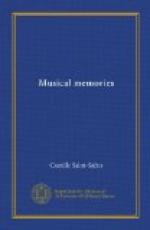To-day Liszt’s Credo is received with wild applause—Victor Hugo did his part-while Cherubini’s is never revived.
CHAPTER XII
THE LISZT CENTENARY AT HEIDELBERG (1912)
The Liszt centenary was celebrated everywhere with elaborate festivities, perhaps most notably at Budapest where the Missa Solemnis was sung in the great cathedral—that alone would have been sufficient glory for the composer. At Weimar, which, during his lifetime, Liszt made a sort of musical Mecca, they gave a performance of his deeply charming oratorio Die Legende von der Heiligen Elisabeth. The festival at Heidelberg was of special interest as it was organized by the General Association of German Musicians which Liszt had founded fifty years before. Each year this society gives in a different city a festival which lasts several days. It admits foreign members and I was once a member as Berlioz’s successor on Liszt’s own invitation. Disagreements separated us, and I had had no relation with the society for a number of years when they asked me to take part in this festival. A refusal would have been misunderstood and I had to accept, although the idea of performing at my age alongside such virtuosi as Risler, Busoni, and Friedheim, in the height of their talent, was not encouraging.
The festival lasted four days and there were six concerts—four with the orchestra and a chorus. They gave the oratorio Christus, an enormous work which takes up all the time allowed for one concert; the Dante and Faust symphonies, and the symphonic poems Ce qu’on entend sur la montagne and Tasso, to mention only the most important works.
The oratorio Christus lacks the fine unity of the Saint Elisabeth. But the two works are alike in being divided into a series of separate episodes. While the different episodes in Saint Elisabeth solve the difficult problem of creating variety and retaining unity, the parts of Christus are somewhat unrelated. There is something for every taste. Certain parts are unqualifiedly admirable; others border on the theatrical; still others are nearly or entirely liturgical, while, finally, some are picturesque, although there are some almost confusing. Like Gounod, Liszt was sometimes deceived and attributed to ordinary and simple sequences of chords a profound significance which escaped the great majority of his hearers. There are some pages of this sort in Christus.
But there are beautiful and wonderful things in this vast work. If we regret that the author lingered too long in his imitation of the Pifferari of the Roman campagna, on the other hand, we are delighted by the symphonic interlude Les Bergers a la Creche. It is very simple, but in an inimitable simplicity of taste which is the secret of great artists alone. It is surprising that this interlude does not appear in the repertoire of all concerts.




